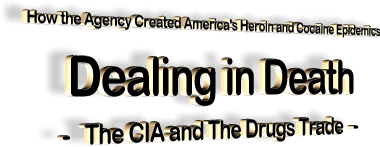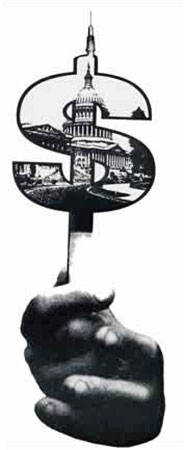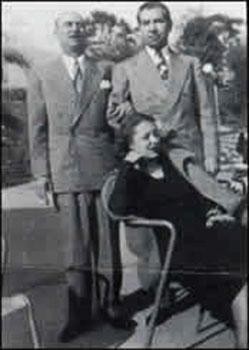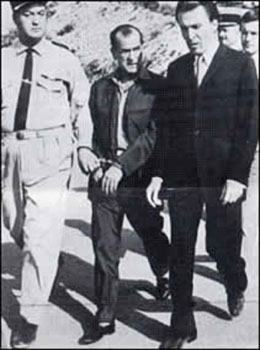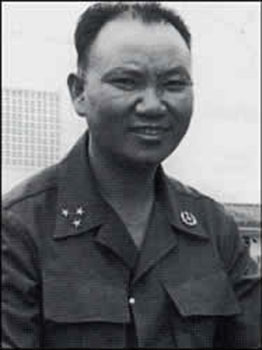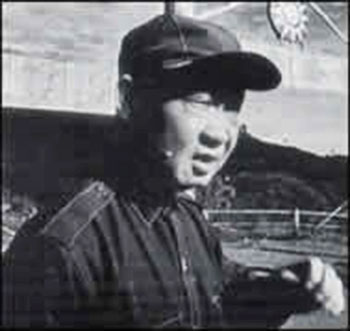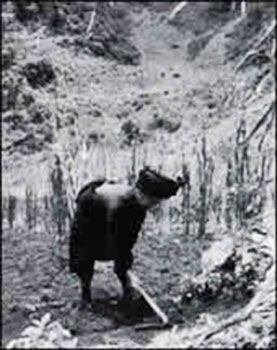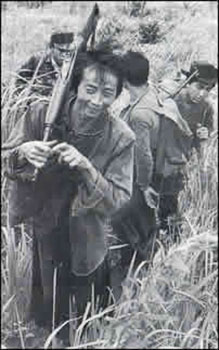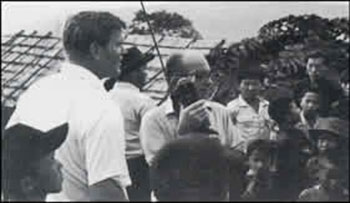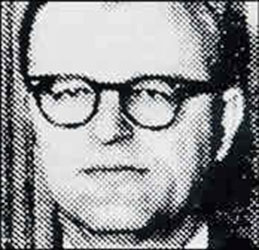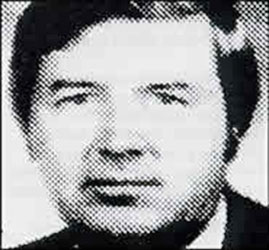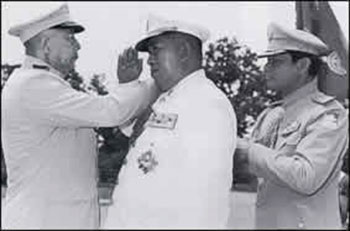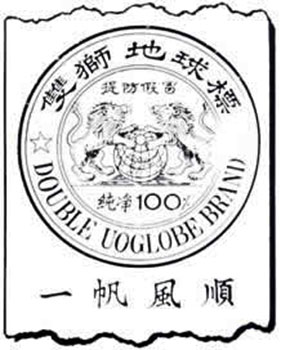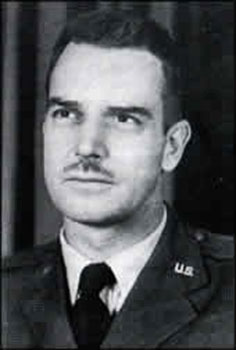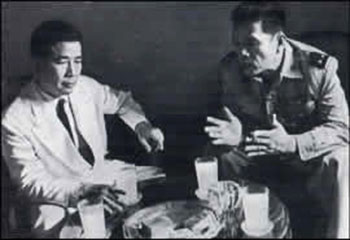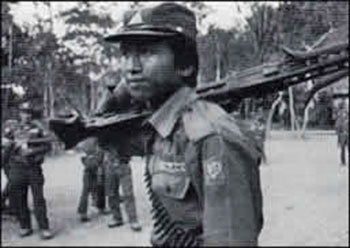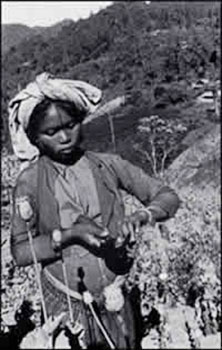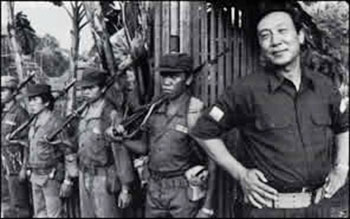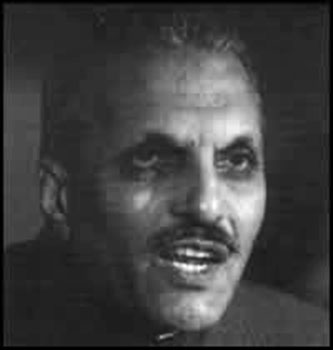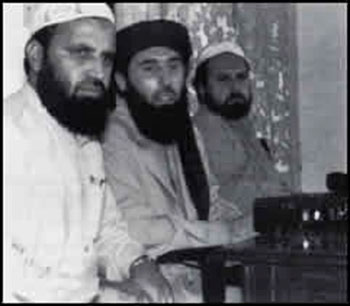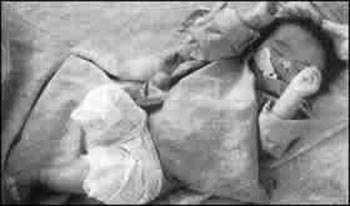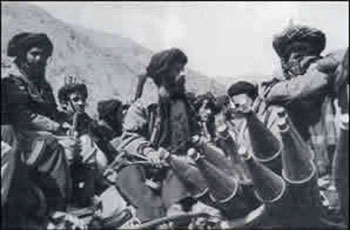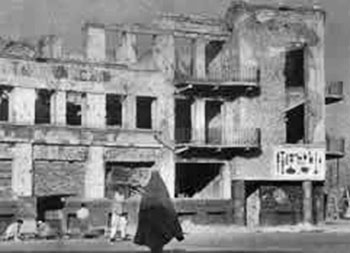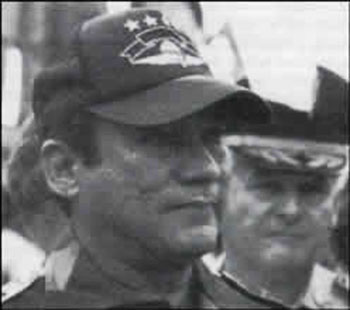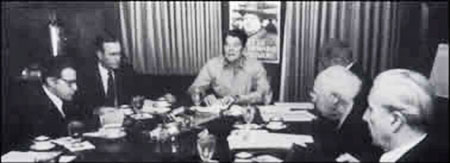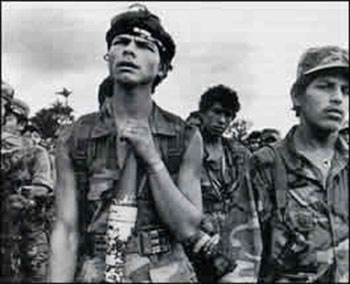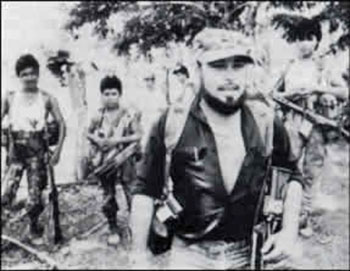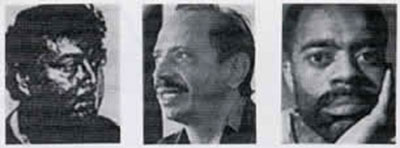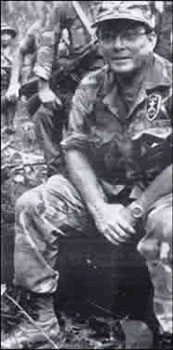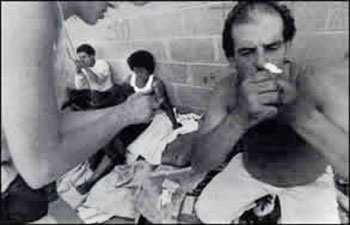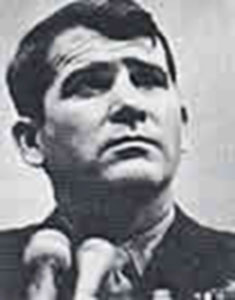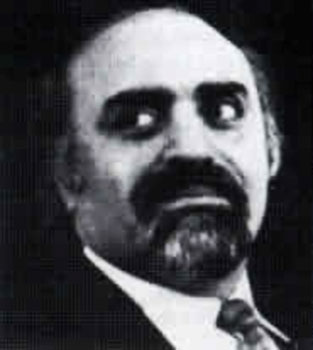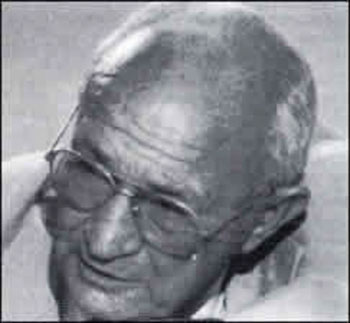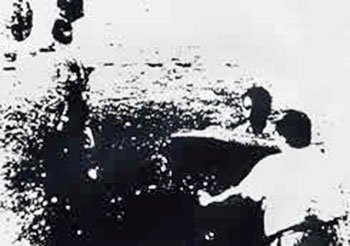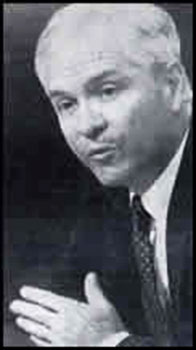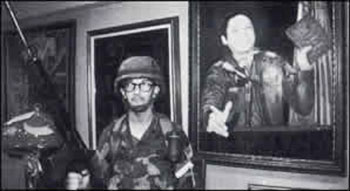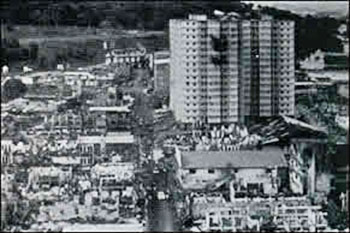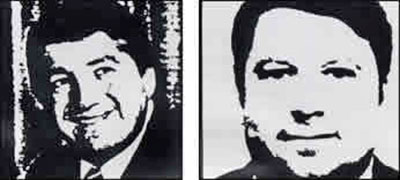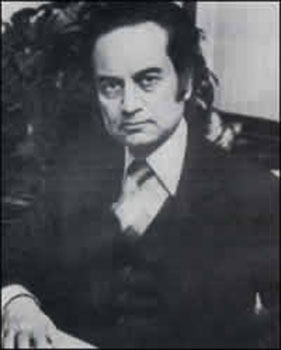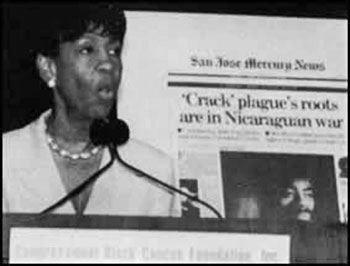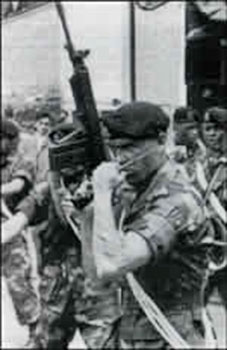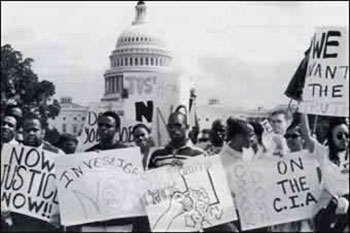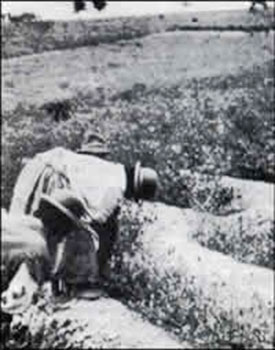|
|
|
2005 from American-Buddha Website
"No one knows what is really going on. If they ever did, it would make Watergate look like Alice in Wonderland." LESTER COLEMAN
ex U.S. Defence Intelligence
Agency
that America's heroin plague is of its own making."
FRED W. McCOY
The Agency has resorted to any means it considers necessary, and allied itself with any person or group it considers necessary, to help it achieve its ends.
As ex-CIA agent Victor Marchetti put it:
The United States government has willingly made drug networks an essential ally in the covert expansion of American influence abroad.
Despite the government's supposedly vociferous anti-drugs policy, senior U.S. diplomats and CIA agents have actively engaged in the production and transport of narcotics worldwide. The CIA's enormous role in the global drugs trade provides one of the murkier narratives of the Agency's sordid history.
As will be shown, the trail of corruption leads to the highest levels of successive Washington administrations, right to the front doors of Presidents,
The CIA has also brought its methodology home to the inner city ghettos in the United States, victimizing American citizens as badly as any foreigners.
In fact, at two critical junctures after
World War II - the late 1940s and the late 1970s - when America's
heroin supply and addict population began to ebb, the CIA's covert
narcotics operations generated a sudden surge of heroin that soon
revived the U.S. drug trade….
When the Agency attempted to assassinate
Fidel Castro in the 1960s, it employed American Mafia syndicates.
CIA operatives directly assisted underworld narcotics traffickers in these areas, aligning together in a fight against Communism and the left.
The CIA has allied itself with heroin
merchants in Laos, Chinese opium dealers in Burma, military drug
lords in Thailand and Panama, Colombian cocaine cartels in Nicaragua
and Costa Rica, and guerrilla opium armies in Afghanistan....
World War II had disrupted international shipping and imposed tight waterfront security that made smuggling of heroin into the United States virtually impossible. Heroin supplies were small and international crime syndicates were in disarray. America's addict population plummeted from 200,000 in 1924 to a mere 20,000 in 1945.
The possibility existed that heroin addiction might eventually disappear as a major social problem in the United States.
However, the CIA and its wartime
predecessor, the OSS (Office of Strategic Studies), created a
situation that made it possible for the Sicilian-American Mafia and
the Corsican underworld to revive the international narcotics
traffic.
After taking control of Sicily, the U.S. army returned favors to the Mafia by appointing Don Calogero Vizzini (the leader of the Sicilian Mafia) mayor of Villalba.
Genco Russo (Calogero's successor as Sicily's Mafia boss) was appointed mayor of Mussumeli. Under the command of Colonel Charles Poletti, the former lieutenant governor of New York, the Allied Military Government selected Mafiosi as mayors in many towns across western Sicily. Within five years the, Mafia controlled politics in Sicily.
As Italian politics drifted to the left in 1943-1944, the alliance between American intelligence and the Mafia was maintained to check the growing strength of the Italian Communist Party in Sicily, Don Calogero rendered services to Washington's anti-Communist efforts by breaking up left-wing political rallies.
On September 16th 1944, for example, a
Communist rally ended abruptly in a hail of gunfire as Don
Calogero's men fired into the crowd and wounded 19 spectators.
Within two years after Luciano's return
to Italy, the U.S. government deported more than 100 more Mafiosi.
The organization's comprehensive distribution network within the United States helped raise the number of addicts from an estimated 20,000 at the close of World War II to 60,000 in 1952 and to 150,000 by 1965.
Luciano became a millionaire many times
over.
At this time the Sicilian Mafia were
relying on Marseilles' Corsican syndicates for their drug supplies.
Spontaneous strikes closed down
factories, mines and railway yards throughout the country and by
late November, three million workers were on strike and the French
economy was almost paralyzed.
However, at the time there were only three major political parties in France - Socialist, Communist and Gaullist. While General de Gaulle was too independent for Washington's tastes, Socialist leaders were rapidly losing political ground to the Communists and thus were willing to collaborate with the CIA.
Agency payments of $1 million to the
Socialist Party guaranteed them a strong electoral base in the
labour movement and gave its leaders the political strength to lead
the attack on strikers.
Police units attacked picket lines with
unrestrained violence, while Communist municipal councilors were
severely beaten up in Marseilles City Hall by members of the Mafia
gang led by the Guerini brothers.
The CIA psychological warfare team prepared pamphlets, radio broadcasts and posters aimed at discouraging workers from continuing the strike.
At one point the American government threatened to ship 65,000 sacks of flour meant for the hungry city back to the U.S. unless the dockers unloaded them immediately. Faced with the overwhelming onslaught of violence and hunger, Marseilles's workers abandoned the strike after less than a month, along with their comrades in the rest of France.
The Guerinis gained enough power and
status from their role in smashing the strike to emerge as the new
leaders of the Corsican underworld in Marseilles.
the Marseilles Mafia leader who fought the Communist Party with the support of the CIA. He was sentenced to twenty years
for a milieu murder
in 1970.
In addition, the Guerini's gangsters
were assigned the job of assaulting Communist pickets to allow
troops and scabs onto the docks.
Gaston Defferre and the Socialist Party
emerged victorious following the weakening of the Communist Party
and the Socialists maintained a political reign over the Marseilles
municipal government that lasted a quarter of a century.
The Corsicans also enjoyed political
protection from France's intelligence service, the SDECE, which
allowed their heroin laboratories to operate undisturbed for nearly
20 years.
Since these demanded alliances with
powerful warlords or tribal leaders who traditionally dealt in
drugs, the Agency enmeshed its covert operations with the region's
opium traffic.
The new Communist regime then began a massive detoxification program to combat its addict population, estimated at 40 million, the largest in the world. Communist cadres identified addicts and sent them to local drug clinics; persistent addicts were dispatched to labour camps. Through the process of land reform, extensive poppy fields were reclaimed for food production and further opium cultivation was banned.
The People's Liberation Army began
patrolling the Chinese border to prevent an expected counter-attack
by CIA-supported Nationalist Chinese troops and China's drug trade
virtually ceased.
These dealers included the Kuomintang (KMT
or Nationalist Chinese) on the Chinese border, Hmong tribesmen in
Laos led by narcotics trafficker Vang Pao, and various
political factions in South Vietnam and Burma.
CIA activities in Burma helped transform
the Shan States from a relatively minor poppy-cultivating area into
the largest opium-growing region in the world, while the CIA helped
install a 12,000-strong opium army in the mountains of northern
Burma.
Commandos were also sent in via small
boats from the offshore island of Quemoy.
But this did not happen and the invaders
were driven out. General Li Mi gave up attempts to defeat China,
established a quasi-independent state in Burma and became involved
in running the lucrative opium trade, aided in this by General
Phao Siyanan of the Thai Police, one of the CIA's most important
agents in Southeast Asia.
The CIA's alliance with the opium armies in the Burma-Thai borderlands lasted for a decade. The Agency delivered arms to their forces in Burma and then loaded opium aboard Civil Air Transport planes for the return flight to Bangkok. Infiltration routes for CIA commando teams into Southern China were also used as drug smuggling routes for traffickers in Burma and Thailand.
The Agency maintained five secret
training camps and two key listening posts in the Shan states,
protected by drug smuggling KMT troops and local tribesmen.
In exchange, Phao allowed the Agency to develop two Thai paramilitary organizations, the Police Aerial Reconnaissance Unit and the Border Patrol Police (BPP).
To manage the training and equipping of
the BPP, the CIA brought in Paul Helliwell, one of their
specialists on forming front companies and laundering funds for
"black" operations, to set up a cover organization operating out of
Miami.
Phao protected KMT supply shipments,
marketed their opium and helped to generate support for the KMT
among Thailand's overseas Chinese community, the richest in Asia.
By 1955, Phao's National Police Department (TNPD) had become the largest opium-trafficking syndicate in the country and was intimately involved in every phase of the narcotics trade.
The level of corruption was remarkable,
even by Thai standards. Police border guards escorted the KMT opium
caravans from the Thai-Burma border to police warehouses in
Chiangmai. From there, police guards brought it to Bangkok by train
or police aircraft. Then it was loaded onto civilian coastal vessels
and escorted by the maritime police to a mid-ocean rendezvous with
freighters bound for Hong Kong or Singapore.
The historical roots of the CIA's secret supply network for the Nicaraguan Contras in the 1980s lie with the Agency's paramilitary programs with the KMT and the BPP in Southeast Asia.
These covert operations provided the
Agency with considerable experience in the management of secret wars
and drug running.
For that purpose it supplied guns, money and training to the Hmong tribe, the part of the Laotian population most eager to fight for the Agency (most were anti-Communist monarchists.) The Hmong's primary cash crop was opium and the CIA provided unmarked Air America UH-1 H helicopters to collect opium for the Hmong commander General Vang Pao from his scattered highland villages and transport it to distribution centers at Long Tieng and Vientiane.
The processed heroin was ultimately
bound for American GI addicts in Vietnam.
The economic alliance between Phoumi and
the Hmong opened up a new trading pattern that supplied increasingly
significant quantities of Burmese opium for the flourishing Laotian
heroin laboratories.
Little more than three months after the elections, Prime Minister Souvanna Phouma and his neutralist government resigned. A new right-wing government took control, declaring:
The State Department provided funds of $3 million a month to the new government.
Backed by the CIA, Phoumi became a
cabinet minister and a general, and with his personal CIA agent
always by his side, plotted coups, rigged elections and helped the
CIA build up its Secret Army in Laos (see later).
All of the CIA operatives moved to adjacent areas of Thailand but returned almost every day by helicopter or plane to direct guerrilla operations.
Civilian personnel (not covered by the Geneva Agreements) were recruited for clandestine operations. In December 1962, for example, CIA agent Edgar Buell trained Hmong guerrillas in demolition techniques and directed the dynamiting of six bridges and twelve mountain passes near Ban Ban.
The U.S. Embassy declared that Air
America flights to Hmong villages, which carried armaments as well
as refugee supplies, were "humanitarian aid" and as such were
exempted from the Geneva Agreements.
This group was known as L'Armee
Clandestine (Secret Army). 40 or 50 CIA officers ran this operation,
later aided by 20,000 Thai mercenaries at a cost of some $300
million a year.
These landing strips were then used by Air America to fly Hmong opium to markets in Long Tieng and Vientiane.
Vang Pao's CIA counterpart Tony Poe later revealed that Vang Pao flew heroin across southern Laos into central Vietnam, where,
CIA chief of station Ted Shackley exercised overall command over the Agency's covert operations in Laos. (He later managed Operation Phoenix, the CIA's mass murder "pacification" program in Vietnam).
Shackley's CIA deputy in Laos, Tom
Clines, managed ground support activities for the war, and U.S. Air
Force liaison Richard Secord, then a lieutenant colonel,
supplied most of the aircraft for Air America and other CIA
proprietary airlines.
This airline flew additional cargoes of
opium and heroin between Long Tieng and Vientiane.
General Ouane
Rattikone (centre),
on his retirement in
June 1971.
Many Hmong villagers had to endure
repeated and long forced marches, which produced fatalities of up to
a third, and most of the Hmong lost their desire to continue
fighting for Vang Pao. They resented his flamboyant excesses such as
personally executing his own soldiers, stealing from the military
payroll and his willingness to take heavy casualties.
Here, Vang Pao paid over half a million
dollars for a cattle ranch, hog farm and two large homes.
General Vang Pao's comment was:
At the same time as it was launching sabotage and guerrilla attacks against the Communist North Vietnamese, the CIA sent Colonel Edward Lansdale to South Vietnam to help install the right-wing regime of Ngo Dinh Diem.
This was one of the CIA's most
successful operations.
Within two years, army medical officers
estimated that 10 to 15%, or 25,000 to 37,000 of U.S. soldiers were
regular heroin users.
The CIA's Senior Liaison Office, under the command of Edward Lansdale, worked closely with South Vietnamese Premier Nguyen Cao Ky's administration during the war, and Ky was heavily involved in narcotics trafficking.
One of Ky's strongest supporters in the
air force, Colonel Phan Phung Tien, was close to many
Corsican gangsters and was implicated in the smuggling of drugs
between Laos and Vietnam.
leading CIA operative during the Agency's drug trafficking activities
in Southeast Asia.
They were flown back to the United States and discharged almost immediately. Virtually none of them were given any follow-up treatment; many returned to their hometowns as confirmed addicts and afflicted their communities with the heroin plague.
A large percentage of these were white middle-class communities that had previously always been free from heroin addiction.
In June 1971, one specialist noted:
Many of the discharged GIs returned to
Vietnam to set themselves up in the drugs trade, recruiting
active-duty soldiers going home as couriers, and using local GIs to
ship heroin to the U.S. through the army and air-force postal
system. A vial of heroin in Vietnam cost only $2; back in the U.S.
it sold for $100.
There is little doubt that the ClA's
support for the traffickers in these countries was responsible for
this massive growth in the drug trade. U.S. officials turned a blind
eye to the region's governments' involvement in the opium traffic,
while the CIA itself was actively involved, supplying modern
aircraft to replace mules, naval vessels to replace sampans, and
providing access to international transport for the opium traders
and commercial contacts to facilitate the marketing of the drugs.
Heroin was following the GIs home.
As South Vietnam fell into a crisis of government corruption and economic collapse, a report by the CIA's Saigon station concluded:
Instead of pressing Thieu for reforms,
the CIA station chief Thomas Polger suppressed the
information.
Kriangsak quickly abandoned the previous
government's anti-drugs policy, stating: "There appears to be a
conflict between our campaign against narcotics and our campaign
against the Communists", and he helped to supply the CIA's
Kuomintang opium armies in northern Thailand with arms and money, in
return for their drugs.
Parading before U.S. television cameras, the KMT's commander, General Li Wen-huan and his troops delivered a hundred mules laden with "opium" and publicly renounced the drug trade.
The Thai military soaked the packs with petrol and set them on fire. With covert funding from the CIA, the Thai military paid the KMT general $1 850,000 for this act.
The U.S. State Department proclaimed that,
As it turned out, the opium pyre was neither the KMT's last shipment, nor entirely opium at all.
Only 5 of the 26 tons had been opium and
the balance was fodder, plant matter and chemicals. Kriangsak and
the Thai military command maintained the fiction that their troops
had now retired from the opium trade, papering over General Li's
long-time links to the CIA, while Li continued with his narcotics
activities as actively as ever.
When the Thai government bowed to public pressure and launched a military assault on Khun Sa's base at Ban Hin Taek near the Burmese border in January 1982, they found the site contained a hundred-bed hospital, a brothel, luxurious villas with swimming pools, a vacation house for General Kriangsak and seven heroin refineries.
The Thai border patrol police had maintained an outpost only a mile from Khun Sa's camp for the past four years but had never disturbed the nearby heroin laboratories.
General Kriangsak was the minister
responsible during this time.
He commands an army of some 4,000 men
armed with M16 rifles and .50 calibre machine guns. In one harvest
he transports enough opium and heroin to supply the entire annual
requirements of America's illicit drug markets.
During the mid 1970s, the temporary success of some Drug Enforcement Agency (DEA) operations in Turkey, Thailand and Mexico reduced the heroin flow into the United States and cut the number of American addicts by more than a half.
However, the CIA's covert warfare
operation in Afghanistan then transformed southern Asia from a
self-contained opium zone into a major supplier of heroin for the
world market.
As heroin from Afghanistan and Pakistan suddenly poured into America throughout 1979, Musto told the White House:
But Dr. Musto's warnings fell on deaf
ears .
And as supply surged, wholesale prices in Europe fell and purity rose to a new high.
With ample supplies of opium and
morphine, Marseilles's Corsican syndicates were co-operating with
the Sicilian Mafia to open a new network of heroin laboratories in
Europe, which then exported heroin to the United States.
Street sales of narcotics in the United
States rose by 22% in 1980, while cocaine supply jumped a remarkable
57% to 44 tons, worth $29 billion.
A DEA expert stated in June 1990:
How did this catastrophe occur?
During the Nixon administration, the CIA, along with the Iranian secret police SAVAK, attempted to destabilize the Afghan government of Hafizullah Amin, which for decades had been allied with the Soviet Union.
The CIA trained and armed a 5,000-strong
army in Pansher valley, north of the capital Kabul. By December
1979, the encroaching threat of the CIA-backed forces and months of
fighting between rival Communist factions meant that the collapse of
the Afghan government seemed imminent. The Soviet Union sent troops
into the country to support its ally, occupying Kabul and installing
a more pliable Afghan Communist as president.
Egypt, Pakistan and China all agreed to help, while Saudi Arabia contributed $25 million.
Within weeks, massive arms shipments began - hand-held missiles and anti-tank weapons from China, Kalashnikov assault rifles from Egypt, munitions from Saudi Arabia and a variety of U.S. weapons from the CIA, including Stinger missiles. The CIA's operation in Afghanistan was the second largest covert war in its 40-year history.
Only its secret war in Laos was bigger
and more expensive.
Pakistan's opium production soared to 800 tons, dominating the European market. Pressured by the United States, an important ally, Pakistan's military regime under General Zia ul-Haq imposed an erratic drug suppression effort that drove the country's opium production down to its more normal level of 100-200 tons.
Afghanistan's mujahedin guerrillas
correspondingly expanded production in their zones and shipped the
raw opium to the Afghan-Pakistan border refineries for processing
into heroin.
The CIA worked closely with Pakistan's
Inter Service Intelligence (ISI), which the Agency helped build into
a powerful covert operations unit and the strong arm of Zia's
martial-law regime.
Pakistani dictator Zia ul-Haq,
aided by the CIA in
his narcotics trafficking.
In particular, the CIA allied with Gulbuddin Hekmatyar, leader of the small mujahedin Hezbi-i Islami group, and over the next decade the Agency gave Hekmatyar more than half its covert aid, building the Hezbi-i Islami into the largest guerrilla force in the country.
Hekmatyar also used the Agency's arms,
logistics and support to become the region's largest drug lord.
Within a year, the surge of his heroin production had captured over
60% of the American market, breaking the long drug drought and
raising America's addict population to its previous peak.
Hekmatyar allied himself with Pakistan's
Jamaat-i Islami (Party of Islam), a fundamentalist and quasi-fascist
Muslim group with many members inside the Pakistani officer corps.
Along the border, the Agency ran
training camps for the mujahedin, and in Pakistan's capital,
Islamabad, the CIA maintained one of its largest foreign stations to
direct the war. General Zia allowed the CIA to open an electronic
intelligence station facing the Soviet Union in northern Pakistan
and permitted U.S. spy flights over the Indian Ocean from his air
bases near the Persian Gulf.
Pakistan's ISI gave Hekmatyar a free
hand to rule the Afghan refugee camps around Peshawar and he used it
to run a reign of terror.
The mujahedin sold the opium to heroin
refiners in Pakistan who operated under the protection of General
Fazie Huq, governor of the North-West Frontier province, and an
intimate of General Zia. Fazle Huq was to accumulate a powerful
fortune from this, estimated at several billion dollars.
whose right leg was
severed by a shell.
Both European and Pakistani police were to later report that all investigations of the province's major heroin syndicates,
Further south, in Pakistan's Baluchistan
province, Hekmatyar himself controlled six heroin refineries that
processed the large opium harvest from Afghanistan's fertile Helmand
valley.
The number of addicts went from a few hundred to more than 1.3 million within three years, one of the world's largest addict populations. Instead of prospering with a bonanza of U.S. aid following the 1979 Soviet invasion, Pakistan was - and still is - destabilized by the immense drug and arms traffic.
Throughout this, some 17 DEA agents sat
in the U.S. embassy at Islamabad without making a major arrest or
seizure - they recognized the potential embarrassment of exposing
CIA operatives, even though they were major drug lords.
By 1989, the CIA's complicity in global narcotics traffic had allowed world opium production to multiply fourfold to 4,200 tons a year.
Significantly, three quarters of this came from Southeast Asia where the Agency had worked with the region's drug lords for 24 years. Most of the balance came from southern Asian opium hills and heroin laboratories controlled by the CIA's Afghan guerrilla clients.
Just as CIA support for KMT forces had
increased Burma's opium crops in the 1950s, so the Agency's aid to
the mujahedin guerrillas expanded opium production in Afghanistan
and linked Pakistan's nearby heroin laboratories to the world
market.
Today, the "Golden Crescent", as the opium growing regions in Afghanistan, Iran and Pakistan are called, accounts for 75% of all the heroin in Western Europe and 50% of the heroin in the U.S.
A Reagan administration official bluntly stated in 1988:
The withdrawal of Soviet troops from Afghanistan in February 1989 resulted in savage fighting between rival mujahedin commanders for the country's prime opium land.
When one of Hekmatyar's commanders
slaughtered thirty members of another mujahedin group, the atrocity
inspired the president of the new Afghan interim government to
denounce Hekmatyar, his own foreign minister, as "a criminal and a
terrorist."
Some 20 training camps sprang up in eastern Afghanistan, mainly in areas under Hekmatyar's Hezb-i-lslami control, teaching such skills as demolitions and assassinations. Many of the participants in the 1993 bombing of the World Trade Centre had combat experience with Hekmatyar's troops.
Ramzi Anmed Youssef, convicted in
New York of plotting to blow up eleven U.S. airliners over the
Pacific, bragged of receiving training in terrorist tactics from the
Agency's Afghan bases.
Led by Mohammed Omar Akhund, the
Taliban viewed the mujahedin as having betrayed their country by
deviating from Islam. They even considered the regime in Iran (from
the rival Shi'ite branch of Islam) as dangerously liberal and
modernizing.
In May 1996, two senior Taliban leaders attended a conference in Washington run by Senator Hank Brown, while senior U.S. diplomats, including Robin Raphael, the Assistant Secretary of State for Asian affairs, regularly traveled to Taliban headquarters. ISI officers aided and flew Taliban planes in their raids on Kabul, which fell to the Taliban militias in September 1996.
On that day, State Department spokesman Glyn Davies touted them as,
John Holtzman, the CIA's station chief in Pakistan, planned to visit Kabul a matter of days later, when the Clinton administration realized that an image of Washington embracing ultra fundamentalists could be a disaster with American female voters.
The visit was postponed.
Of the UN's 185 members, Pakistan alone rushed to recognize the Taliban government.
John Holtzman told reporters:
Well-armed Taliban fighters
shortly after the
capture of Kabul.
People were forced at gunpoint to attend
the mosque. Women were barred from education and from work. Men were
ordered to grow beards. Television, music, sports and even
kite-flying were banned. The Taliban snatched music cassettes from
cars and smashed them with rocks by the roadside. Women caught
exposing an inch of skin in public were beaten with baseball bats.
The U.S. firm Unocal and the Saudi group Delta Oil had reached an agreement with the former Soviet republic Turkmenistan for a multi-billion dollar natural gas pipeline which would go through Afghanistan into Pakistan.
A friendly Taliban government would
ensure the project's feasibility and security - and also help
prevent the creation of a similar pipeline proposed by Pakistan and
Iran. Indeed, this may have been the largest single factor behind
the U.S. government's acceptance and continued funding of the
Taliban, which has helped them achieve military success across the
whole country.
In fact the UN estimated an increase in
poppy cultivation and yield in the 1995-6 growing season - when the
Taliban held 95% of the area under cultivation - compared to the
previous year.
was supported by Reagan, Bush and the CIA, even though they knew he was heavily involved
in cocaine
trafficking.
In 1962, Noriega joined the National Guard and was made chief of transit police by Major Omar Torrijos Herrera, who was on the payroll of the CIA.
Torrijos was also working for the Agency
in monitoring the potential threat of Communist influence among
banana growers in Puerto Armuelles and Bocas del Toro. These
plantations were owned by the United Fruit Company, a powerful
American corporation that was also a CIA front.
In mid-1970, Noriega became a member of
the Counterintelligence and Counterespionage Organisation, an
international network of intelligence agencies.
Israel was chief amongst them, selling
their arms first to Somoza, then to the Guatemalan military
dictatorship and later to the Contras.
Noriega was heavily involved in the tidal wave of Colombian cocaine sweeping into America.
The Medellin drug cartel (a
highly-organized consortium of Colombian cocaine brokers with an
annual income estimated at $8 billion) paid Noriega vast sums of
money for allowing them access to secure airstrips and aircraft in
Panama, for making certain that customs and immigration officials
asked no questions, for laundering drug profits through Panamanian
banks, and for allowing wanted traffickers to remain in the country.
A former Senate intelligence Committee member recalled from that period:
Another U.S. official said at the time:
On December 8th 1976, Noriega traveled to Washington D.C. where he first made the acquaintance of George Bush, the Director of the CIA.
When Bush left this position the following year, he sent a letter to Noriega, thanking him for his assistance. Another contact between the two came when Bush became Vice President.
Noriega sent a letter of congratulations and Bush sent a reply (dated December 23rd 1980) saying:
Noriega thrived as never before under the Carter administration.
He provided a haven in Panama for the Shah of Iran while Carter was seeking the release of the American hostages held in Iran, and when the Sandinistas took over Nicaragua in 1979, Noriega provided the CIA with the most regular and reliable intelligence about them.
Torrijos too was involved in (futile)
efforts to preserve Somoza's National Guard as a counterbalance to
total Sandinista control of the country.
(In 1967 Rodriguez was the head of the
CIA-backed Bolivian troops who captured and killed Che Guevara,
the Cuban revolutionary leader).
George Bush's office was the central
command post for the whole operation.
Argentina began training about a
thousand men, mostly former Somozan National Guards, into an
anti-Sandinista paramilitary army, north of the Nicaraguan border in
Honduras. These were the forces who would become known as the
Contras.
In each of the countries where they set
up training units for the Contras, the Argentine advisers encouraged
the use of violence and political assassinations.
Reisse recruited, amongst others, two
key anti-Communist Cubans into the Argentine training apparatus:
Jose Suarez, who became a hit man for the Colombian cocaine Mafia,
and Felix Rodriguez.
The key financier behind the coup was
Juan Ramon Matta Ballesteros, known as "chief of the Honduran
Mafia."
In March 1980, President Carter even
hosted General Paz at the White House.
For the following three years, Matta and
Paz worked hand in hand with the army to build Honduras up as an
even larger cocaine trafficking centre.
Contra forces dealt drugs and used the profits
to enrich themselves
and to buy arms.
Thus, the use of covert drug money to
help the Contras' funding problems took on an even greater appeal to
the United States. This was in complete contradiction to President
Reagan's much-vaunted anti-drug posturing for the American public's
benefit.
The Panamanian air cargo company Aviones de Panama, run by three of Noriega's personal pilots, Cesar Rodriguez, Floyd Carton and Enrique Pretelt, flew weapons from Panama to bases in Costa Rica for Contra operations on the Southern Front.
They dropped off the guns at Costa Rica,
refueled, and flew on to U.S. bases in South Florida, loaded with
cocaine and under the protection of the CIA.
Panama, a tax haven with one of the
Western Hemisphere's tightest bank secrecy laws, was a favored spot
to stash illicit drug profits.
"I smuggled my share of illegal
substances, but I also smuggled
Contra re-supply pilot
By 1984, the airline had become the
Contra group's chief mover of supplies, personnel and narcotics. The
FDN paid for these services through bank accounts established by Lt.
Col. Oliver North of the National Security Council.
There, they planned how they could use
the Contras' drug operations to raise funds. Blandon returned to Los
Angeles and began selling cocaine to Ricky "Freeway" Ross, a
22-year-old street dealer with ties to the Crips street gang in Los
Angeles.
At the same time, Meneses supplied
cocaine to street gangs in the San Fransisco Bay area.
Blandon was described as "the biggest Nicaraguan cocaine dealer in the United States," while Ross was widely considered to be the first crack-dealing millionaire to rise from the streets of South Central Los Angeles.
Together, Blandon and Ross created a tidal wave of crack that swept into low-income American neighborhoods in the mid-1980s.
The black community was ravaged by a
drug crisis of historic proportions, resulting in "crack" babies,
record drug overdoses, unprecedented numbers of black male youth
incarcerations, a rise in AIDS and numerous other afflictions.
CIA-funded Contra leader.
Jack Blum, special counsel to the Subcommittee on Terrorism, Narcotics and International Operations to the Senate Foreign Relations Committee investigating the CIA's links to Contra crack smuggling, testified in October 1996:
The racist nature of the crack epidemic meant that the black community was afflicted the worst.
The lingering effects of the epidemic
can be seen today, where, for instance, in Los Angeles County alone,
there are more than 70,000 children in foster care for drug-related
reasons. In Washington DC, out of the thousands of cases of
neglected and abused children removed from homes, 90% involved crack
mothers.
Meneses visited Contra camps numerous
times and sent people to Honduras to work for them. When the scandal
of the affair broke out, the CIA initially insisted that Meneses was
not a key player in the Contra war and denied it knew anything about
his involvement with drugs. After being instructed to conduct a
search, the Agency admitted that it had records going back to 1984
implicating Meneses in drug trafficking.
Blandon pleaded guilty in 1992 to distributing cocaine for Meneses and selling it to Ross. At his trial, the judge banned evidence of Blandon's CIA connections and ordered it to be sealed at the prosecution's request.
Money-laundering charges against Blandon were dropped at federal request.
The DEA sprung Blandon from jail and
gave him $166,000 to become an informant for them. Blandon earned an
additional $45,000 from the DEA for entrapping his former customer
Ross, who was convicted of conspiracy to distribute cocaine in 1996.
When Oliver North formed his covert network to fund the Contras after the aid cut-off, he brought in Major General Richard V. Secord, U.S. air force liaison for the CIA, to establish a clandestine arms supply operation.
(Secord had been in charge of supplying
most of the aircraft for the CIA's covert operations in Laos.
Secord, in turn, recruited Thomas Clines, who had been deputy in
command of CIA operations in Laos).
Felix Rodriguez' business partner, the international arms dealer Gerard Latchinian, together with former Honduran military commander General Jose Bueso, were arrested when FBI agents seized 763 pounds of cocaine worth $10 million, at a remote airstrip in southern Florida.
The purpose of the drug shipment was to finance a coup and assassination plot against the elected president of Honduras, Roberto Suazo Cordova, and to reinstate General Gustavo Alvarez Martinez, Bueso's former boss and patron of the Contras.
Despite being implicated in death squad killings from his days as head of the police and army, Alvarez had led a comfortable life in the United States, where he worked as a consultant to the Pentagon.
He was awarded the Legion of Merit by the President, the highest award that can be presented to a foreign military officer. General Bueso and Latchinian were eventually convicted on murder-for-hire conspiracy charges.
The Justice Department called this plot to assassinate a foreign head of state,
Yet Oliver North and U.S. General Paul Gorman both testified on Bueso's behalf and requested that the U.S. Department of Justice grant leniency, on the grounds that Bueso had been a "valuable ally to the United States" in aiding the Contras.
Both Bueso and Latchinia are still
serving prison sentences in the U.S. They have never been questioned
regarding their activities for the CIA.
Ghorbanifar arranged weapons deals with Iran for North, including the sale of at least five HAWK and TOW missile shipments in 1985-6.
These secret missile deals formed part
of the arms-for-hostages swaps with Iran and violated the Arms
Export Control Act.
In turn, Rodriguez disclosed that he paid Manuel Noriega $4-10 million per month for protection of drug and money shipments from Colombia.
From 1979 to 1983, the payments to
Noriega totaled $320 to $350 million. Noriega had a deal with U.S.
officials that one per cent of the gross income from his drug deals
was set aside to buy additional weapons for the Contras.
This led to the disclosure that Hull, a CIA liaison in Costa Rica, was allowing his property to be used for airdrops of weapons organized by Oliver North for the Contras. The pilot of the plane, Teofilo Watson, who was killed in the crash, was a member of Floyd Carlton's smuggling operation.
Oliver North's diary itself notes that Contra supply planes were,
On a weekly basis, the CIA obtained army truck loads of cocaine directly from the Medellin cartel in Colombia, which they flew north to Costa Rica.
John Hull was paid by the CIA for allowing his airstrips to be used as a refueling stop, before the drugs were flown on to the United States. In exchange, the drug traffickers paid user fees and made payoffs to the Contras. At the direction of North, Hull received a stipend of $10,000 per month from the Contra command in Honduras.
On the return trips from southern
Florida, the pilots brought plane loads of weapons back for the
Contras.
When Hull's activities became the subject of a criminal fraud investigation by the U.S. Attorney for the Southern District of Florida, U.S. officials in Central America did their best to protect him from arrest.
To date, nothing has happened with the
case, but the Justice Department maintains that the investigation is
still ongoing.
The CIA tried to blame the attack on the Sandinistas.
After jumping bail from Costa Rica, John
Hull found sanctuary in the United States, the country professing
"zero tolerance" for drug smugglers, where he remains a free man.
All attempts by Costa Rica to extradite him have failed.
cocaine smuggler and
CIA operative.
The Agency installed a hidden camera in
a C-130 cargo plane owned by Adler "Barry" Seal,
a convicted American drug dealer turned informant, who worked
closely with Vice President Bush's "anti-drug" task force in
Washington and who managed the Colombian cartels' drug shipments
into the United States.
The photograph was leaked to the press and was immediately given massive coverage by all the major papers, radio stations and TV networks.
President Reagan displayed the photo in
a nationally televised speech in March 1986, as proof that the
Sandinistas were involved in drug running and terrorism.
DEA officials also testified that Oliver
North had suggested to them that the $1.5 million in drug money
carried aboard Seal's plane be provided to the Contras.
Spadafora was brutally tortured and murdered on September 15th 1985, having last been seen in the custody of the Panamanian Defence Forces.
An investigation conducted by the
Organization of American States (OAS) implicated the Panamanian
government in the murder but the U.S. State Department resolutely
refused to pursue the case. The CIA station chief in San Jose, Costa
Rica, Joe Fernandez, assisted in covering up Noriega's role
in the crime.
All of Central America - Guatemala, Costa Rica, El Salvador, Honduras and Panama - was knit together into an anti-Nicaraguan alliance. The CIA plan was to split the country in two, east to west, attacking from the north through Honduras and from the south through Costa Rica, and capturing Managua by Christmas.
U.S. ground forces could not become directly involved in any such war without violating American law and inviting massive domestic and worldwide protests. But Panama could assist the Contras in an invasion, much as the Argentineans had helped to train the Contras in early 1981.
However, Noriega responded that it would
be impossible for Panama to become involved in such a major overt
operation. Poindexter responded by threatening both Noriega
specifically and Panama in general.
Noriega met North and Major General
Richard Secord at the Victoria Hotel in London to discuss
further sabotage against Nicaraguan economic targets, including an
oil refinery, an airport and the electric and telephone systems.
Dearborn met with General John Singlaub, whose World Anti-Communism League was raising funds for the Contras.
Singlaub made Dearborn his Air
Operations Adviser while General Secord set about building up a
separate operation that would fly out of Ilopango Air Force Base in
El Salvador. Fat profits were made in these arms deals, although
only a fraction ever reached the Contras.
Among the documents found on board the crashed plane were the Air America's operator's manual and a roster with the names and addresses of every ex-member of the CIA who had joined the Air America Club. The pilot and co-pilot both died in the crash but the Sandinistas captured and jailed the third occupant, CIA agent Eugene Hasenfus.
The U.S. government denied all involvement in the airdrop, claiming that the whole thing was planned, financed and executed by a group of "freedom-loving patriots."
The real truth was that it was an
operation financed and sanctioned by the highest levels of the White
House.
They wanted Morales to provide them with weapons and financial help, and in exchange they offered to use their connections with the CIA to help drop Morales' indictment for narcotics smuggling. Morales entered into an agreement with these men to bring guns down to Central America for the Contras and fly cocaine back to the U.S.
The drugs would be sold in the U.S. and
the money would go to the Contras.
Morales testified:
One form of assistance given by the CIA to the traffickers was intelligence information to help them avoid detection when entering the United States. Morales was assured by the Agency that his phone lines would not be monitored by the DEA, and he was provided with information on air traffic patterns and clearances for military planes.
Michael Tolilver disclosed that he was allowed to use a U.S. military installation, Homestead Air Base near Miami, to smuggle drugs into the United States.
An FBI informant, the wife of a
Colombian drug trafficker, testified that a federal judge, a U.S.
Customs official and an air traffic controller in Miami were taking
bribes from the drug dealers.
In 1990, Carrasco agreed to testify against his former boss Abello, in exchange for immunity from prosecution on his own drug trafficking charges.
Under oath, Carrasco described in startling detail how in the autumn of 1984, Contra leaders directed Morales to land cocaine-filled planes at public airports in south Florida, assuring him that the flights would be "protected."
On one of the flights to North Miami's
bustling Opa-Locka airport, Carrasco's plane landed in the late
afternoon and taxied to a hangar where more than 400 kilos of
cocaine packed in military-style duffel bags were unloaded on the
tarmac in plain view of federal agents.
Among those who worked directly for or with Seaspray were,
It almost beggars belief that the
operatives supposedly helping the fight against the drug smugglers
should be those very same people intricately involved with assisting
the drugs trade in the first place.
The stated purpose of the Task Force was specifically to keep drugs out of south Florida - an objective it spectacularly failed to achieve.
This was not surprising considering the
intricate involvement in the Contra drugs rackets of both
Bush and his
family (see later).
They greatly expanded the narcotics
distribution and money laundering in Miami and also helped train
Contras under John Hull's command.
The CIA assistance was channeled to a new BNDD intelligence office established under Lucien Conein, a veteran CIA covert operations specialist who boasted of the trust he enjoyed in the Corsican underworld.
By the end of 1974, Conein's Miami
operation, known as DEACON 1, had not contributed to the bust of a
single drug ring. But an official review of DEACON 1 indicated that
it had sanctioned drug smuggling by its own agents, while its
principal agent was said to be "reporting on civic and political
groups" as well as supervising other agents.
...who, despite their records for long-time drug trafficking, terrorism and murder, were allowed to continue extensive drug smuggling into the United States while enjoying near-immunity from prosecution.
According to charges filed in 1986, Tarbraue's syndicate earned $79 million from importing narcotics into the U.S. between 1976 and 1987, while given protection from the deputy police chief of Key West and various Miami police officers.
When prosecutors learned, to their
amazement, that Tabraue had begun trafficking under government
protection, the judge declared a mistrial.
CORU was set up with the active support of the CIA and the acquiescence of the FBI in order to,
One Miami police veteran reported:
The Director of the CIA at the time of
CORU's founding was George Bush.
...in the first ten months of its existence.
One of CORU's leading organizers told an interviewer in 1977:
Years later, Ricardo Morales himself took credit for the airline bombing, saying he planned it at the CIA's instigation.
Venezuelan authorities investigating the
plane bombing arrested amongst others, Luis Posada, a
long-time agent of the CIA. Posada also had materials in his
possession linking him to the assassination of former Chilean
ambassador Orlando Letelier in Washington DC a month earlier,
although the FBI suppressed the evidence.
An unpublished congressional staff study of WFC found that it encompassed,
Five of CORU's founders, including Frank Castro, later joined the Contras.
Castro was instrumental in bringing
together the Contras' intelligence, terrorist and criminal forces,
and was involved with some of the biggest cocaine smuggling rings of
the decade.
Four years later, Vice President Bush's
national security advisor Donald Gregg sent Villoldo to
advise the Contras on military strategy.
Prescott Bush Jr., the Vice President's brother, and Robert McCauley, a close friend of George Bush and CIA Director William Casey, founded a shadowy "disaster relief" organization called AmeriCares, a CIA front working with Oliver North's network, which flew shipments of "humanitarian aid" to the Contra organization run by Mario Calero, brother of Adolfo Calero.
George Bush had extensive links with the
ex-CIA Cubans in Miami. His son Jeb, a Miami resident, became his
father's personal representative in the Miami Cuban community and
sometimes hosted his father's frequent Republican fundraisers in the
city.
The very first effort by Pastora's new air force, supplied by the CIA, was to blow up the civilian Augusto Cesar Sandino Airport in Managua on September 8th 1986, using a twin-engine Cessna light aircraft with a 500-pound bomb strapped under each wing. The airport normally would have had two anti-aircraft guns in place, but reports of the bombing raid had been leaked to the Sandinistas and that morning they had increased the number of anti-aircraft guns to seventeen.
The Contras' plane was shot down and
crashed into the control tower and the terminal building. The pilot
of the plane had the name and phone number of a CIA operator from
the U.S. Embassy in Costa Rica in his pocket, and other papers,
which were identified as authentic CIA documents.
Their plane circled for about 45 minutes before it was re-routed to Honduras. Had the senators arrived at the airport on time, they would probably have been killed by the CIA's cohorts. The VIP room where the senators were due to have given their press conference was destroyed by the blast.
Angrily facing the CIA station chief in Managua the following day, the senators were told by the station chief:
who might have been
killed as a result of
if their plane had
landed on schedule at the Managua airport.
These companies were:
The State Department paid over $800,000 to these four companies between January and August 1986.
After one of their planes was forced down in Florida, on September 23rd 1985, with 900 pounds of cocaine, Floyd Carlton and Alfredo Caballero were indicted and eventually convicted of smuggling narcotics into the United states and laundering $2.6 million in drug proceeds. Carton got nine years. Caballero was sentenced to only five years' probation.
This case led to the 1988 indictment in
Miami of Manuel Noriega for drug trafficking.
In August 1987, the CIA's Central American Task Force chief confessed:
Only ten months previously, Congress had lifted the ban on aid for the Contras in order to prevent them being decimated, and had approved a further $100 million in funds on top of two payments of $13 million and $27 million in "humanitarian aid."
Former National Security Council official Norman Bailey testified:
The House Foreign Affairs Committee reported:
None of these allegations apparently made any impression on Vice President Bush, coordinator of the Reagan administration's War on Drugs.
Bush's top drug aide, Admiral Daniel Murphy, declared:
Nonetheless, by the late 1980s, in spite of Washington's official denials, Noriega's widely known involvement in drug trafficking and corruption was becoming an increasing liability.
When the Iran-Contra scandal blew up and the whole White House program of covert support for the Contras came crashing down, Noriega suddenly became expendable. Panama was becoming less important to Washington as a transit point for supplies to the Contras because the CIA was sending covert military supplies via Ilopango Air Force Base in El Salvador.
Noriega's shady pursuits were now
interpreted as a security threat to the U.S.
The military used repressive measures in
crushing the protests, but the prospect of future political turmoil
in Panama, and the fear of a left-wing party taking control of
Panama, finally prompted Washington's campaign to oust Noriega from
power.
Negotiations were held in which the U.S. government agreed to dismiss the indictment if Noriega would step down from power. Noriega refused and on December 21st 1989, some 24,000 American troops invaded the country and ousted Noriega.
The invasion was launched with the full
knowledge that "We are going to hurt people," as Colin Powell,
chair of the Joints Chief of Staff put it. The bombing devastated
residential areas, killed or injured thousands of civilians and
forced thousands more into homelessness.
Others were burned to death in their homes. There were bodies in the streets for nearly a week afterwards.
The Red Cross was not permitted to recover bodies of either the wounded or the dead to transport them to the hospitals or the morgue. U.S. troops also opened fire on the ambulances.
An estimated 2,000 to 4,000 died that
night in El Chorrillo, yet the massive civilian casualties caused by
the invasion were covered up by a compliant U.S. media.
after the U.S. invasion of Panama. The US indictment of Noriega was largely a public relations stunt designed to disguise Washington's involvement
with the dictator and
his shady activities.
Meanwhile Oliver North, a traitor to the
Constitution and a liar to Congress over the Iran-Contra affair,
went scot-free and in certain U.S. circles was accorded the status
of folk hero.
The commission concluded that the Contra
re-supply network in Costa Rica, which North coordinated from the
White House, doubled as a drug smuggling operation.
Top officers of the G-2 military intelligence unit and the brother of President Cerezo have all been implicated in major cocaine smuggling rings.
The United States has responded to this by increasing its support to the military to,
Human rights observers charge that the military's support for aerial spraying of herbicides over guerrilla-held territory, ostensibly to eradicate opium poppies, is yet another tactic in the ten-year-old counterinsurgency war against the left-wing guerrillas - a means of denying them food supplies.
As one former top Guatemalan official explained:
Far from benefiting the country, the results of U.S. military aid are growing drug problems and worsening human rights abuses.
The Guatemalan military has been
responsible for massive brutality, including 100,000 deaths and
40,000 disappearances. No action has ever been taken against
military officers implicated in death squads, which target human
political activists and human rights workers.
In fact Clinton was up to his neck in the Contra cocaine and gunrunning rackets. A small dirt airstrip at Mena, Arkansas, was a major U.S. landing site for the Contra drugs and arms network, handling a night flight without lights every five minutes at the height of the activities.
Bill Clinton was governor of
the state at the time and allegedly protected the operation,
blocking investigations by local prosecutors into the illegal
activities there.
Lloyd Bensen, the Texas Democrat senator who strongly supported the Contras, was appointed Treasury Secretary by Clinton.
Clinton also employed, in the Arkansas Development and Finance Administration, a Contra supporter named Larry Nichols. (It was Nichols who exposed Clinton's affair with Jennifer Flowers during a court case following Nichols' dismissal from his job.)
Clinton was well known for sending his state's National Guard to Honduras for training in what amounted to Contra-supporting activities.
Clinton's brother - who was convicted
of cocaine possession - was also involved as an associate of Barry
Seal, a major organizer of the Contra supply network and pilot for
the Medellin cocaine cartel.
Amongst the various pardons for
convicted cocaine traffickers and money launderers issued by Clinton
two hours before handing over power in 2001 was a pardon for
Harvey Weinig, who had been jailed for laundering $19 million
for the Cali drug cartel.
The chief smuggler involved in running
guns to the Contras and bringing drugs back to the U.S. via Mena was
Barry Seal. As Arkansas Governor, Clinton did nothing to shut down
Seal's known drug flights into Mena; in fact, the future president
and his cronies benefited from the laundering of drug funds through
Arkansas financial institutions.
This scam of North's, named Operation
Donation, enabled him to circumvent the Congressional ban on aid
to the Contras, whilst plane and boat owners would claim the
insurance money and lose nothing themselves.
Reed's bosses, including Felix Rodriguez, were not pleased by his refusal to continue his work in Mexico.
Reed's "stolen" plane from five years
ago was secretly returned to its hangar, just as a passing private
investigator (who happened to be a friend of Bill Clinton) was
walking past, while the wind conveniently happened to blow the door
open, revealing the plane.
Eventually in 1988, Reed was acquitted, perhaps because he had expressed his wish to subpoena Oliver North and Felix Rodriguez. The judge concluded that the private investigator and Buddy Young, the Arkansas State official involved in the prosecution, both had a "reckless disregard for the truth."
Buddy Young was Bill Clinton's state security chief. Vital evidence supporting Reed's claims was withheld by Clinton's camp for a year after it should have been handed over to the court.
Reed is currently prosecuting the
Arkansas officials - including Buddy Young - who tried to frame him.
Some of the largest and most respectable
banks happily turn a blind-eye to their clients' covert drug
activities and earn massive commissions from laundering dirty money.
Recent forensic testing carried out
randomly throughout the United States revealed that virtually every
single banknote contained microscopic traces of cocaine.
Arms and military hardware are happily exchanged for narcotics, which are in turn peddled for money that is used to finance further black operations. This approach to money raising on the part of the intelligence services reveals a long history of entanglements with the Mafia.
The exposures of the BCCI and Nugan Hand Bank led to spectacular revelations of how the CIA uses the international financial community to finance its murky covert operations...
One of the founding partners of the
bank, Michael Jon Hand, was a Green Beret who served with the
CIA for two years, fighting with Hmong guerrillas in northern Laos.
It was here that he acquired the expertise in narcotics that he
later applied to building the bank.
The two set up Nugan Hand Ltd. in 1973, through a gross financial fraud. With only $80 in the company's bank account and just $5 in paid-up capital, Frank Nugan wrote his own company a personal cheque for $980,000 to purchase 490,000 shares of its stock.
He then covered his massive overdraft by
writing himself a company cheque for the same amount. Through this
accounting fraud, Nugan could claim that the company's paid-up
capital was a million dollars.
Over the next six years, the bank grew
at a remarkable rate by providing a bridge between larger,
legitimate banks and a shadowy web of organized crime, illegal money
laundering and covert intelligence operations.
whose death and disappearance exposed
the CIA's involvement
in the drug laundry profession.
The bank issued lavish promotional brochures describing itself as,
Over the next few years, the bank divided into two almost separate companies:
Hand took on as a third partner one
Maurice "Bernie" Houghton, a Texan who had worked
for the CIA in Southeast Asia during the Vietnam War. The
Hand-Houghton partnership led the bank's international division in
the fields of drug finance, arms trading and support work for CIA
covert operations.
Under the cover of Task Force 157,
Wilson placed an order for 10 million rounds of ammunition, 3,000
weapons including machine guns, M-1s, and carbines. With an
end-user's certificate showing Wilson's cover company, World Marine
Inc. in Washington, as the purchaser, the arms left the United
States from Boston for southern Africa in three separate shipments.
The money was used to finance covert paramilitary operations such as the supply of the Contras.
A central figure in the handling of Vang Pao's drug profits was former naval officer Richard L. Armitage, whose official duty in Thailand was "special consultant" to the Pentagon.
However, Armitage actually functioned as a "bursar", overseeing the transfer of Vang Pao's heroin profits to Shackley's Nugan Hand account in Tehran. From late 1973 until the ultimate withdrawal of U.S. forces from Indochina in April 1975, money was smuggled out of Vietnam in large suitcases by Secord and Clines, and deposited in a secret Nugan Hand account in Australia.
Armitage later became Assistant
Secretary of Defence for International Security Affairs.
After nearly 50 years without a serious
narcotics problem, Australia suffered increasing addictions in the
late 1970s, as the Sydney criminal syndicates organized regular
heroin shipments from Southeast Asia's Golden Triangle.
Branch manager Neil Evans later revealed:
Michael Hand told Evans that the bank was to become the CIA's paymaster,
The office closed in July 1977. In the
brief period of its existence, Evans claimed to have secured $3
million in narcotics money.
After each transfer, one of Riley's underlings would call at Nugan Hand's Hong Kong office to pick up the money, later using the cash to take delivery of a heroin shipment.
Through this procedure, Nugan Hand
handled $4.3 million in identifiable drug money for 26 known dealers
between 1976 and 1980.
For example, Admiral Earl Yates, retired chief strategist for the U.S. Pacific Command, served as president of Nugan Hand Bank.
Other senior appointments included:
Castle Bank operated as a laundry for
both CIA and organized crime funds. In addition, an investment firm
for which Helliwell was counsel mingled CIA funds with dirty money
from Philippine dictator Ferdinand Marcos.
Depositors included Playboy publisher Hugh Hefner, Penthouse publisher Robert Guccione and some major organized crime figures - Morris Dalitz, Morris Kleinman and Samuel Tucker.
Elated by the discovery, the IRS formed Project Haven to make,
Then suddenly the IRS announced that it was dropping the investigation because of "legal problems."
An investigation by the Wall Street Journal revealed that,
The CIA warned that "national security" would be endangered because it was using Castle Bank for the funding of clandestine operations against Cuba and other countries in Latin America and the Far East.
By the time Helliwell died from
emphysema on Christmas Eve 1976, Castle Bank had been liquidated.
Wilson, Bernie Houghton and the CIA's
Tom Clines discussed ways of using Nugan Hand Bank to float a $22
million loan to finance the delivery.
It was being investigated for fraud; leading commercial banks were warning customers of the bank's alleged drug dealings; and the auditors were refusing to approve the books at several branches. An independent audit of the Nugan family's fruit packing business in Griffith turned up accounts in the names of local drug dealers and evidence of corporate fraud.
When minority shareholders mounted a
challenge to the Nugan family's management, Frank Nugan and his
brother Ken hired one of Sydney's leading crime figures, retired
police detective Frederick Krahe, who filled the annual
meeting with a legion of crooks, each armed with a single share of
stock, to force approval of the company's stocks.
There was a run on Nugan Hand Bank offices in Sydney that took out about 30% of total deposits. A month later, an opposition leader speaking on the floor of the state parliament accused the Nugan fruit company of drug dealing.
Frightened by the investigations, Frank
Nugan began stealing from the bank accounts to fund the legal and
public relations battle for the family's fruit business. Over the
next two years, he stole $1.8 million, an amount sufficient to
destabilize the bank's shaky finances.
Nugan promptly called a meeting of Sydney staff and ordered them to clean up the bank's business by passing the,
On January 27th 1980, Australian police found the body of Frank Nugan, with a bullet hole in his head, in a Mercedes parked by the side of a country road, 100 miles west of Sydney.
Nugan was still holding the rifle he had apparently used to shoot himself in the head.
He was also holding a bible that contained an embarrassing list of names, including,
Beside each name were listed amounts running into five and six numbers.
Following public outrage, the U.S.
Senate began an investigation into Nugan Hand's operations.
Houghton called at Ed Wilson's Geneva office on the day of Nugan's death and left a briefcase with bank documents for safekeeping. Several months later, one eyewitness recalled watching while CIA agent Tom Clines went through the briefcase at Wilson's office and removed one sheet of paper with his own name on it.
When General Richard Secord's name was mentioned during the search, Clines said:
Two days after Nugan's death, Michael Hand went to the bank's offices at Sydney and told the directors that if they did not co-operate with him in the administration of the Nugan Hand Group, dissatisfied clients would cause them all,
Assisted by the duly co-operative staff
and the dutiful Admiral Earl Yates, Hand and Houghton led a
systematic destruction of the bank's records.
Hand, using an Australian passport under
an assumed name, flew to Fiji and Vancouver, escorted by James
Spencer, an ex-Green beret who had served in the CIA's Laos
operation with him. Hand crossed the border from Canada into
America, where he disappeared.
However, they had overlooked the man's unusual necklace and within days the British police identified him as the New Zealander, Martin Johnstone, one of Nugan Hand's drug clients. Johnstone was a member of the so-called "Mr. Asia Drug Connection," primarily based in New Zealand and Australia, which shipped large quantities of heroin from the Golden Triangle worldwide.
Johnstone had been in charge of
supplying Mr. Asia's British market with heroin by way of Singapore.
In July 1983, Sinclair began talking about his intelligence connections and how laundered money from drug sales was used by the CIA for arms purchases. The Australian Royal Commission investigating Nugan Hand called for the extradition of Sinclair, but the British authorities refused. On August 17th 1983, Sinclair conveniently died as he was walking to lunch in Parkhurst Prison.
It was said that he collapsed but no
official cause of death was offered. He was 39 years old.
The federal prosecutor, Lawrence
Barcella, had evidence that Clines was simply the front man in a
criminal conspiracy.
Instead of pressing on with the indictment to force full revelations, another federal prosecutor allowed Clines to admit his individual guilt, pay a $10,000 fine and return $3 million in stolen funds.
Denying any involvement, General Secord
resigned from the Pentagon with his pension intact.
The Agency's operatives involved in this scandal came from the highest positions of power in the CIA and had all held practical experience in the CIA's covert drug running operations elsewhere in the world.
"It wasn't just that BCCI was rumoured
to be bad. It was that professional
It operated as a corrupt organization
throughout its 19-year history. It systematically falsified its
records and knowingly laundered the illegal income of drug dealers
and other criminals, and it paid bribes and kickbacks to public
officials in many countries.
It had branches in more than 70 countries but the bank's main office was in London. BCCI also had major centers in the Cayman Islands and Luxembourg, where banking regulations are virtually non-existent. Here it utilized its operations to move money around the world for arms deals and intelligence operations, through a convoluted web of accounts and shell companies designed to camouflage the transactions.
The BCCI people in all of the countries in which it operated were on a first-name basis with the prime ministers, presidents and finance ministers in these countries, and even their wives and mistresses.
A close friend of Agha Hassan Abedi, was
former President Jimmy Carter.
president of BCCI, at
his London office.
The First American network had been
secretly acquired by BCCI with the help of Sheikh Kamal Adham,
the founder of Saudi Arabia's intelligence services, together with
Richard Helms and Clark Clifford ("retired" from the
CIA but still connected to senior members of the U.S. intelligence
community).
William Casey, Director of the CIA, met every few months with Agha Hassan Abedi in the 1980s, to discuss the use of CIA accounts to finance the Contras and the mujahedin in Afghanistan, and to bribe General Noriega. At BCCI's Panama City branch, Noriega deposited $33 million, much of which came from the CIA and other U.S. intelligence agencies.
George Bush's sons George Jr. and
Jeb were also tied to BCCI.
Investigators found a cheque to Pakistan's President Zia from BCCI for 40 million rupees ($2 million) - a not-too subtle BCCI effort to curry favour with Zia in 1986 at the height of the CIA's Afghan operation.
Retired senior Pakistani intelligence
officials were employed by Attock Oil and International Travel
Corporation, companies connected to BCCI. The father of Amjad Awan
of BCCI-Miami, who managed Manuel Noriega's accounts, was a former
head of Pakistan's ISI intelligence agency. BCCI shareholder Prince
Turki working closely with ISI, distributed more than $1 billion in
Saudi funds to the mujahedin in the 1980s.
In Asia, BCCI's clients included the world's biggest heroin dealer Khun Sa.
BCCI officers met with and opened accounts for such major Colombian drug cartel leaders as Pablo Escobar, Jorge Luis Ochoa and Jose Gonzalo Rodriguez Gacha.
In Florida, the bank handled accounts
for some 200 drug traffickers and tax evaders. In all, according to
estimates by U.S. investigators, the bank laundered nearly $1
billion in Colombian drug profits.
The arms dealer and drug merchant Manucher Ghorbanifar and the multimillionaire Saudi businessman Adnan Khashoggi used BCCI extensively to finance weapons deals with Iran on behalf of the covert arms network set up by Oliver North and Richard Secord.
In one 1986 arms deal with Iran, BCCI
moved $10 million back-and-forth from the Credit Suisse Bank four
times. The transactions mysteriously produced £40 million of sale,
and therefore additional profit.
The NSC also maintained accounts with
BCCI, which were used to support the Contras.
According to the deal, the release of U.S. hostages held by Iran would be delayed until after the November 1980 election. Iran, in return, would receive U.S. arms via Israel after Reagan was sworn in as president.
A large volume of U.S. arms was
subsequently shipped to Iran through Israel after Reagan's
inauguration in January 1981.
THE MIAMI NARCO-BANKING
NETWORK
When Nugan Hand collapsed in 1980,
Beazley moved on to become president of the City National Bank of
Miami. The bank's new owner was Alberto Duque, a Colombian
wheeler-dealer who also became involved with George Bush's son Jeb
in the construction of a downtown Miami high-rise.
In 1982, Duque's former New York
partner, Eduardo Orozco, was arrested and convicted of running the
largest money laundering operation ever uncovered in the U.S. Most
of the funds were deposited with the CIA-linked exchange firm Deak
Perera. In 1986, Duque was found guilty on 60 counts of fraud and
conspiracy.
The Somozas and other South American
dictators bought Well out of the glare of public scrutiny, leading
banks have sinister connections with up Miami mansions and filled up
local banks. One Florida real estate agent estimated that of all
foreign purchases in 1979, only 20% were the product of legitimate
money.
The Popular Bank and Trust Company,
which was owned by deposed Nicaraguan dictator Anastasio Somoza
until his death in 1980, was used by the State department to
transmit funds to the Contras.
In another Savings and Loans bust that cost $200 million in a shady land deal, the money disappeared via Du Pont's St. Joe Paper Co. Jersey, one of the Channel Islands.
It is now believed that the looted funds were used by the CIA to procure weapons for Iraq. A central figure in the Savings and Loans fraud was Walter Mischer, a long-time acquaintance of George Bush.
Mischer was closely connected to the New
Orleans Marcello family, one of the most powerful Mafia clans in the
country.
Palmer National Bank's board included,
Palmer National's clients included the National Endowment for the Preservation of Liberty (NEPL) who provided $10 million to Oliver North's covert networks to Nicaragua and Iran.
This operation was the brainchild of the
CIA's William Casey.
Just as the Agency distributed LSD in the 1950s and 60s (which helped to reduce the effectiveness of the anti-establishment youth movement at a time of great domestic social unrest), so heroin from Southeast Asia flooded black communities at the height of the urban rebellions of the late 1960s.
Similarly, the epidemic of crack cocaine
in America's inner cities in the 1980s helped to crush any
potentially effective movements among the nation's angry,
disenfranchised blacks.
During a demonstration by 2,000 Los Angeles blacks to protest about the CIA's involvement in importing Contra crack cocaine into the U.S., Maxine Waters, a congresswoman representing LA's South Central district, one of the areas worst hit by the crack epidemic, declared:
By lumping all drugs together as an evil threat (conveniently ignoring tobacco and alcohol, which are responsible for more deaths annually than all the banned narcotics combined), the justification is laid down for a clampdown on civil liberties and the passing of draconian laws.
Electronic surveillance, agent
infiltration and "sting" operations were increased greatly during
the course of the anti-drugs campaigns introduced by Nixon and
Reagan.
The new legislation permitted the Pentagon to provide information, equipment, facilities and training to domestic law enforcement agencies worldwide.
At the same time, the Justice
Department's Office of Legal Counsel issued a secret opinion that
U.S. military personnel can apprehend accused drug traffickers
abroad - a power they do not have in the U.S. Even more ominously,
the U.S. military can act without host country consent.
It authorized $15 million worth of
military equipment for Colombia, supposedly allocated for
counter-narcotics but which was in fact diverted to fund
counterinsurgency programs against the left.
For example, in Colombia, on August 18th 1991, members of the army's counterinsurgency XIII Brigade burst into the home of political activist Antonio Palacios Urrea, murdered him and three of his children, and tortured other family members. U.S. military documents leaked to Amnesty International confirmed that counter-narcotics funding was going to this unit.
U.S. Defence Department documents showed that all but one of the Colombian Army brigades implicated in massive human rights violations turned out to have received U.S. aid.
Further U.S. and Colombian military
documents showed that in 1991, the CIA was directly involved in
helping design and fund 41 clandestine intelligence networks for the
Colombian Defence Ministry. According to a classified ministry
order, the networks' only function was to target "leftist
subversion."
Colonel Warren D. Hall, head of Clinton's anti-drug crusade, admitted in an internal memo:
According to Javier Giraldo, a Jesuit priest and founder of Colombia's Inter-Congregational Commission for Justice and Peace:
U.S. Green Berets continue to train the Colombian army in illegal paramilitary operations.
The Clinton administration escalated aid to the Colombian military to record levels, while insisting that this assistance was for counter-narcotics. More than $600 million will be used for drugs interdiction programs, including equipment and training for three elite counter-narcotics battalions, and the construction of radar bases and intelligence networks.
Thirty hi-tech UH-60 Blackhawk and 33
Huey helicopters will be lent.
elite
counterinsurgency unit.
In late October 1996, President Clinton sent General Barry McCaffrey to Peru to meet Vladimiro Montesinos, the head of the National Intelligence Service (appropriately acronymed SIN) and praised him as,
Montesinos had extensive links to the CIA and to international drug traffickers, as well as a history of human rights abuses, including disappearances of his political opponents, torture and executions.
During the 1970s, Montesinos became the
lawyer-of-choice for Peru's drug kingpins. More than 300 military
personnel under his control have been investigated or charged in
connection with drugs since 1990.
McCaffrey's visit to bestow Washington's seal of approval on Montesinos was preceded by a personal letter from President Clinton praising Peru's human rights record and its,
Such is the deceitful nature of
Washington's anti-drugs campaign.
A pretext has been laid down for an
increase in the training of foreign security forces by U.S. military
advisers, and for further clampdowns on immigrants into the U.S.
Even Secretary of Defence Caspar Weinberger spoke out against military involvement in the drug war:
Given the vast scale of corruption in
Latin American military organizations, Washington's strategy of
further militarizing these societies is hopelessly
counter-productive, not only for controlling drugs but also for
fostering peace and democracy.
On that basis, who exactly are the
terrorists and who are the victims?
But instead of reducing or repressing drug supply, most security agencies operate by protecting favored dealers and eliminating their rivals; the result is an inevitable increase in drug trafficking.
As special counsel Jack Blum put it:
By adopting a policy of accepting any effective ally in the war against Communism, the CIA has, over decades, actively helped many of the world's leading drug lords, and has restrained other agencies from dealing with the drugs trade.
America's drug epidemics have been fuelled by narcotics supplied from areas of major CIA operations, while periods of reduced heroin use have coincided with the absence of CIA activity.
These facts speak for themselves and provide some of the most damning evidence of the repugnant morality of America's intelligence services, the system that they serve, and their undermining of the democratic process. It is critical to note that support for drug trafficking is sanctioned and sustained by the highest levels of U.S. officialdom.
It is not just the CIA but the entire U.S. foreign policy apparatus, including,
...that are complicit in drug
trafficking as an essential part of the Agency's covert operations.
over CIA-Contra-crack
links.
So long as there is a market for drugs in the First World, the Third World will find ways of supplying it.
America's heroin suppliers have responded to any attempts at local law enforcement by shifting their supplies from one country to another, remaining one step ahead of U.S. narcotics agents, while increasing their smuggling routes and often expanding, rather than reducing their drugs production and distribution.
If cocaine supplies slacken in one
country, heroin exporters in other countries stand ready to fill any
void in the market. For example, the eradication of Turkey's opium
crops in the early 1970s raised the world market price and
encouraged increased production by poppy farmers in Afghanistan and
Burma.
Military repression fails to take into account the fact that the cultivation of crops essential to illegal drug production is propelled by global economic policies that have relegated developing nations to producing goods for the developed world, and away from producing food for their own populations.
Millions of peasants, indeed entire
national economies, depend on the drug industry. Quick-cash crops
like coca leaves, opium and hashish are by far the most profitable
means of sustaining a living for hill farmers in poppy-growing
regions of the Third World.
U.S. financial institutions also benefit
from the large quantities of drug money that are channeled through
them and allowed to be invested in the economy.
targets peasant
growers, not social conditions.
During the 1980s, Charles Rangel, chair of the House Select Committee on Narcotics Abuse and Control observed:
The recent explosion in these numbers precisely parallels the increased use in narcotics and the accompanying proliferation of drug-related violence - a fact conveniently ignored by politicians who would rather see the blame pinned on the victims of the policies that have caused the problem in the first place.
While intoning "Just Say No [to drugs],"
President Reagan slashed spending for social programs, aid to the
inner cities and other policies which would have improved conditions
for the nation's poorest.
The very illegality of drugs such as
opium allows their trade far greater profits than any other
commodity, producing enormous incomes for criminal networks, with
which they can purchase enough protection - politically and
militarily - to survive any attempt at suppression.
If half of America's crack users are
under 21, a limited legalization might well expand drug abuse among
teenagers, while adult addicts could survive by buying limitless
quantities of legal drugs and marking them up for resale to
teenagers. The police would have no control over a market mechanism
that could spread abuse and addiction to unseen levels.
This could be applied in five specific areas:
Unless such policies are applied with
some urgency, the real war on drugs will never be won.
|

